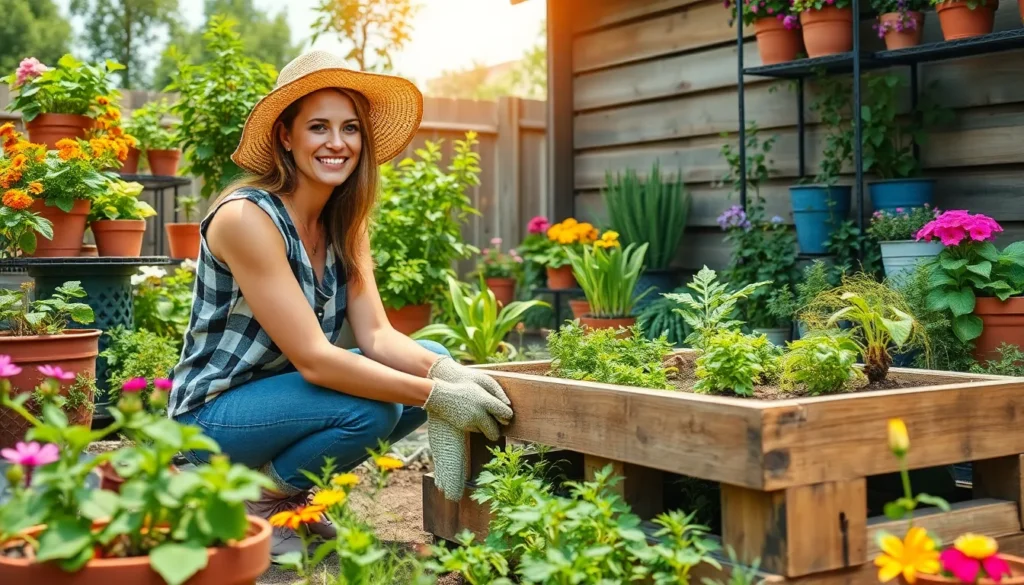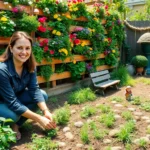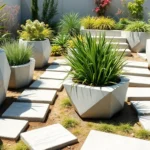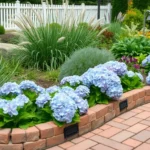Creating a beautiful garden doesn’t require acres of land or a massive budget. We’ve all dreamed of having our own green sanctuary but felt overwhelmed by the costs and space limitations that seem to stand in our way.
Whether you’re working with a tiny backyard, a small balcony, or just a few square feet of outdoor space, we’ll show you how to transform any compact area into a thriving garden paradise without very costly. From clever container answers to DIY planting hacks, there are countless ways to maximize your space while minimizing your expenses.
We’ve compiled the most effective budget-friendly strategies that’ll help you grow fresh herbs, vibrant flowers, and even vegetables in the smallest spaces. You don’t need to spend hundreds of dollars or have a green thumb to get started – just a little creativity and the right approach can turn your gardening dreams into reality.
Start With Free or Low-Cost Seeds and Cuttings
Building our garden’s foundation doesn’t require expensive seed packets or nursery plants. We can gather quality seeds and cuttings through resourceful methods that cost almost nothing.
Save Seeds From Grocery Store Produce
Seeds from store-bought fruits and vegetables offer an excellent starting point for our budget garden. Tomatoes, peppers, cucumbers, and squash contain viable seeds that we can dry and plant next season. We simply scoop out the seeds, rinse them clean, and spread them on paper towels to dry for one to two weeks.
Bell peppers yield 20 to 40 seeds per fruit, while a single tomato can provide 100 to 300 seeds depending on its variety. Citrus fruits like lemons, oranges, and grapefruits also produce seeds that grow into attractive houseplants or outdoor trees in warmer climates.
Herbs purchased from the grocery store often contain seeds as well. Cilantro, dill, and fennel frequently go to seed, giving us fresh planting material for future harvests. We store our dried seeds in labeled envelopes or small jars in a cool, dry place where they’ll remain viable for several years.
Ask Friends and Neighbors for Plant Cuttings
Plant cuttings from friends and neighbors provide free propagation material that grows into full-sized plants within months. Succulents root easily from leaf cuttings, while herbs like basil, mint, and rosemary develop roots when placed in water for two to three weeks.
Perennial flowers such as lavender, geraniums, and chrysanthemums propagate successfully through stem cuttings taken in spring or early summer. We cut 4 to 6 inch stems just below a leaf node, remove the lower leaves, and place them in potting soil or water until roots develop.
Most gardeners gladly share cuttings from their established plants, especially when we offer to trade or reciprocate with our own plant materials. Many houseplants like pothos, philodendrons, and spider plants naturally produce offshoots that experienced gardeners are happy to share with newcomers.
Visit Local Seed Swaps and Community Gardens
Seed swaps and community gardens connect us with fellow gardeners who exchange seeds, seedlings, and growing knowledge at no cost. These events typically occur in spring and fall at libraries, community centers, and farmers markets throughout most cities and towns.
Community gardens often maintain seed libraries where members contribute excess seeds and take what they need for their plots. Master Gardener programs, sponsored by local universities, frequently organize seed exchanges and educational workshops that welcome beginners and experienced gardeners alike.
Local gardening groups on social media platforms host virtual seed swaps where members mail seeds to each other across the country. We can find rare varieties, heirloom seeds, and regional favorites that aren’t available in stores while building relationships with other gardening enthusiasts who share our budget-conscious approach.
Repurpose Household Items as Creative Planters
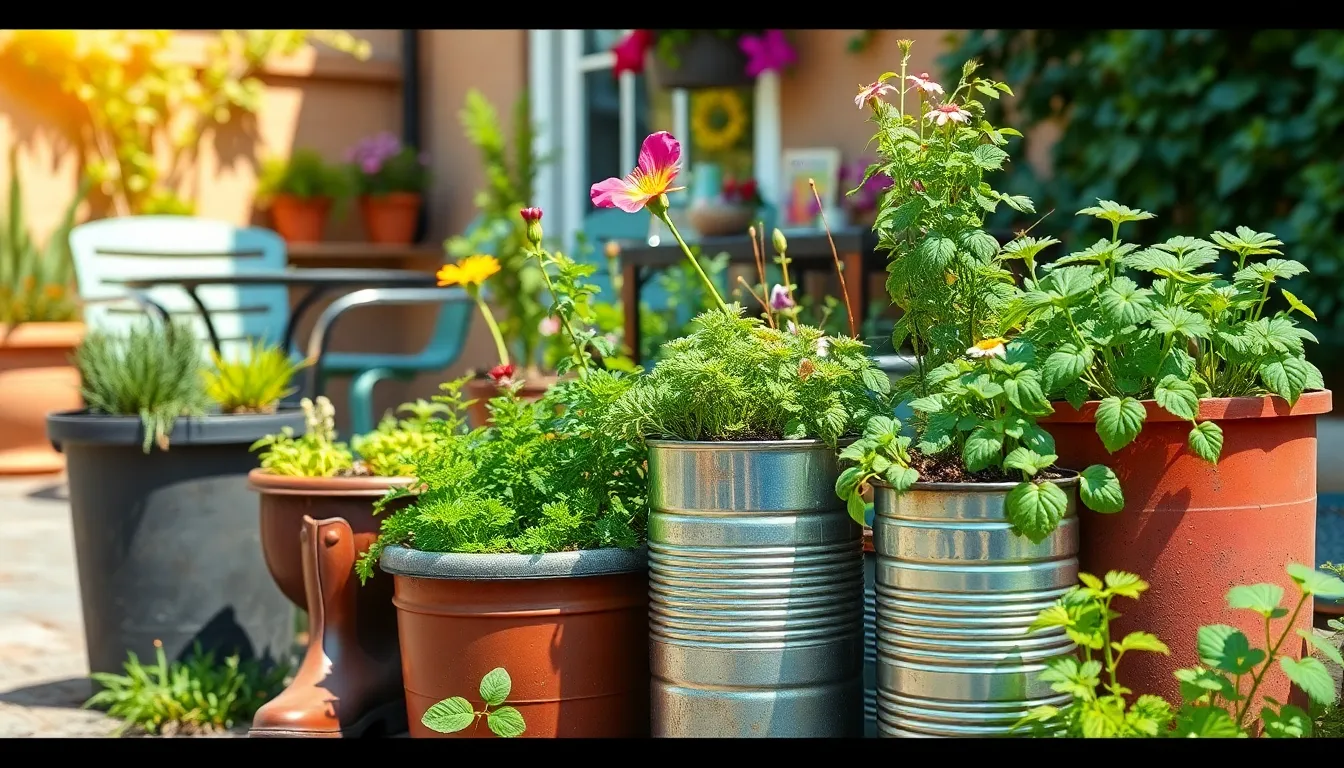
Everyday items sitting around your home can become the foundation for our budget garden transformation. We’ll show you how common household objects can serve as unique planters that cost nothing but deliver impressive results.
Transform Plastic Containers Into Growing Vessels
Large plastic tubs and buckets make excellent planters for vegetables and flowers. We recommend cleaning these containers thoroughly before use and drilling several drainage holes in the bottom. Yogurt containers, milk jugs, and detergent bottles work perfectly for smaller plants like herbs and lettuce.
Food storage containers offer ideal growing space for root vegetables. Deep plastic tubs accommodate carrots, radishes, and potatoes with room for proper root development. We’ve found that clear containers allow us to monitor root growth and soil moisture levels effectively.
Old laundry baskets lined with industry fabric create drainage friendly planters. These containers work exceptionally well for strawberry plants or trailing flowers that can cascade through the basket openings.
Use Old Boots and Shoes as Quirky Plant Holders
Rubber boots and rain shoes provide waterproof containers perfect for small herb gardens. We suggest using these for oregano, thyme, and other compact herbs that don’t require deep root systems. Wellington boots work especially well because their height accommodates plants with longer stems.
Canvas sneakers and fabric shoes create charming displays for succulents and air plants. These breathable materials allow proper drainage while adding personality to our garden spaces. We’ve discovered that high top sneakers offer more soil volume for slightly larger plants.
Children’s outgrown shoes make adorable mini planters for windowsill gardens. Small sandals and Mary Jane shoes work perfectly for tiny cacti or single herb cuttings that we want to propagate.
Convert Tin Cans Into Herb Garden Containers
Large tin cans from tomatoes and beans create perfect sized containers for basil and parsley. We punch several holes in the bottom using a hammer and nail to ensure proper drainage. Removing labels and cleaning thoroughly prevents any residue from affecting plant growth.
Smaller cans work ideally for starting seedlings before transplanting. Soup cans and vegetable cans provide just enough space for germinating seeds and early root development. We’ve found these containers particularly useful for starting lettuce and spinach from seed.
Coffee cans offer deeper growing space for herbs with longer root systems. These containers accommodate rosemary, sage, and other woody herbs that need more soil depth. We often group several coffee can planters together to create attractive herb garden clusters on patios or balconies.
Create Vertical Growing Spaces to Maximize Your Area
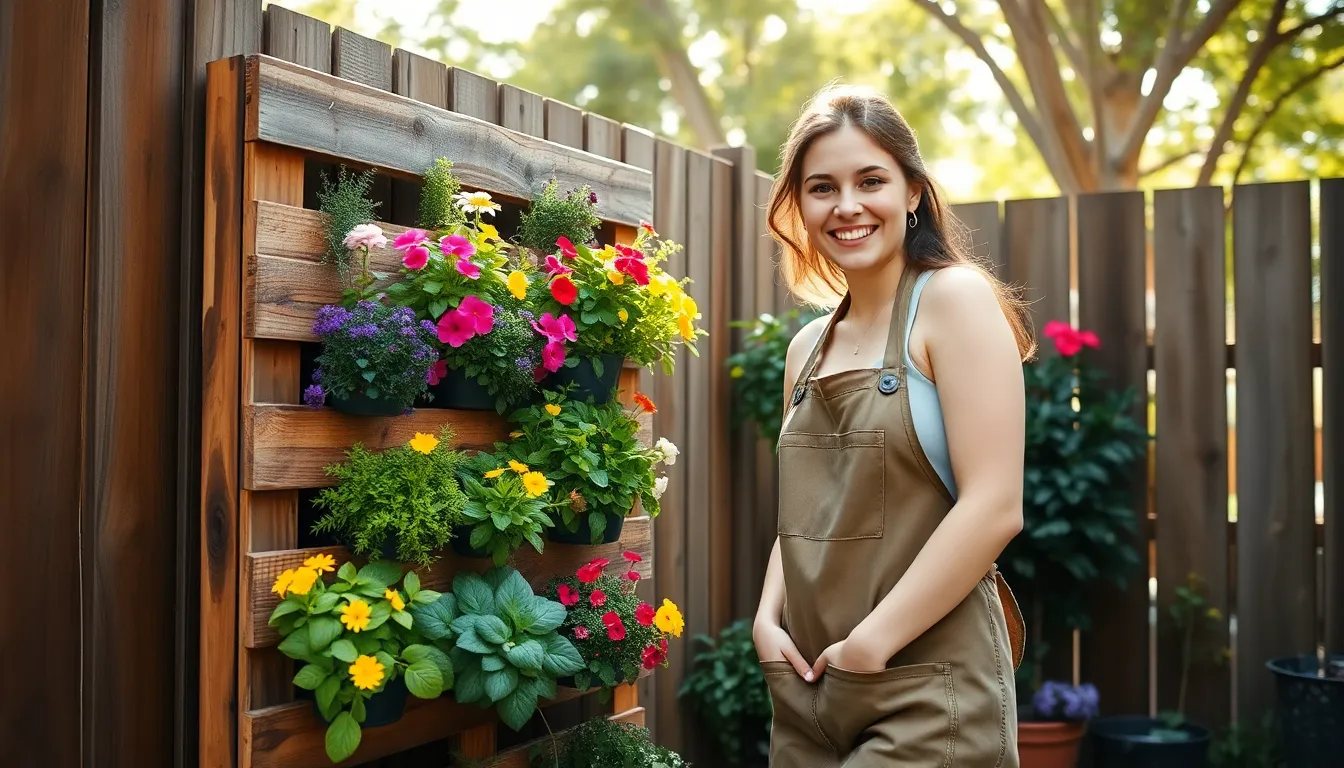
Building upward transforms even the tiniest spaces into productive growing areas. We’ll show you three effective methods that work perfectly for budget conscious gardeners.
Build Simple Pallet Gardens for Wall Mounting
Repurpose old pallets to create stunning wall mounted planters that cost almost nothing. We find wooden pallets at construction sites, shipping companies, or furniture stores where they’re often discarded for free.
Transform your pallet by attaching it securely to a fence or wall using heavy duty screws. Fill the spaces between slats with industry fabric to hold soil in place. Add potting mix and plant herbs like basil and oregano or flowering plants such as petunias and marigolds.
Position your pallet garden where it receives adequate sunlight for your chosen plants. Water regularly since wall mounted gardens dry out faster than ground level plantings.
Install Hanging Baskets From Existing Structures
Use existing structures like porches, gazebos, or sturdy tree branches to hang baskets filled with your favorite plants. We recommend checking what you already have before purchasing new hanging hardware.
Select lightweight containers such as coconut fiber baskets or plastic planters to reduce stress on mounting points. Fill baskets with trailing plants like cherry tomatoes, strawberries, or cascading flowers such as ivy geraniums and lobelia.
Hang baskets at different heights to create visual layers and maximize growing space. Water hanging baskets more frequently since they experience increased air circulation and faster moisture loss.
Stack Containers to Create Tiered Planting Systems
Stack containers of varying sizes to build impressive tiered gardens using terracotta pots or DIY planters made from dollar store buckets. We place the largest container at the bottom and progressively smaller ones on top.
Create drainage holes in each container if they don’t already exist. Fill each level with appropriate potting mix for your chosen plants. Plant larger specimens like tomatoes or peppers in bottom containers and herbs or flowers in upper tiers.
Arrange your tiered system near a water source for easy maintenance. Move individual containers as needed to adjust sun exposure or create seasonal displays throughout your small garden space.
Focus on High-Yield, Easy-to-Grow Plants
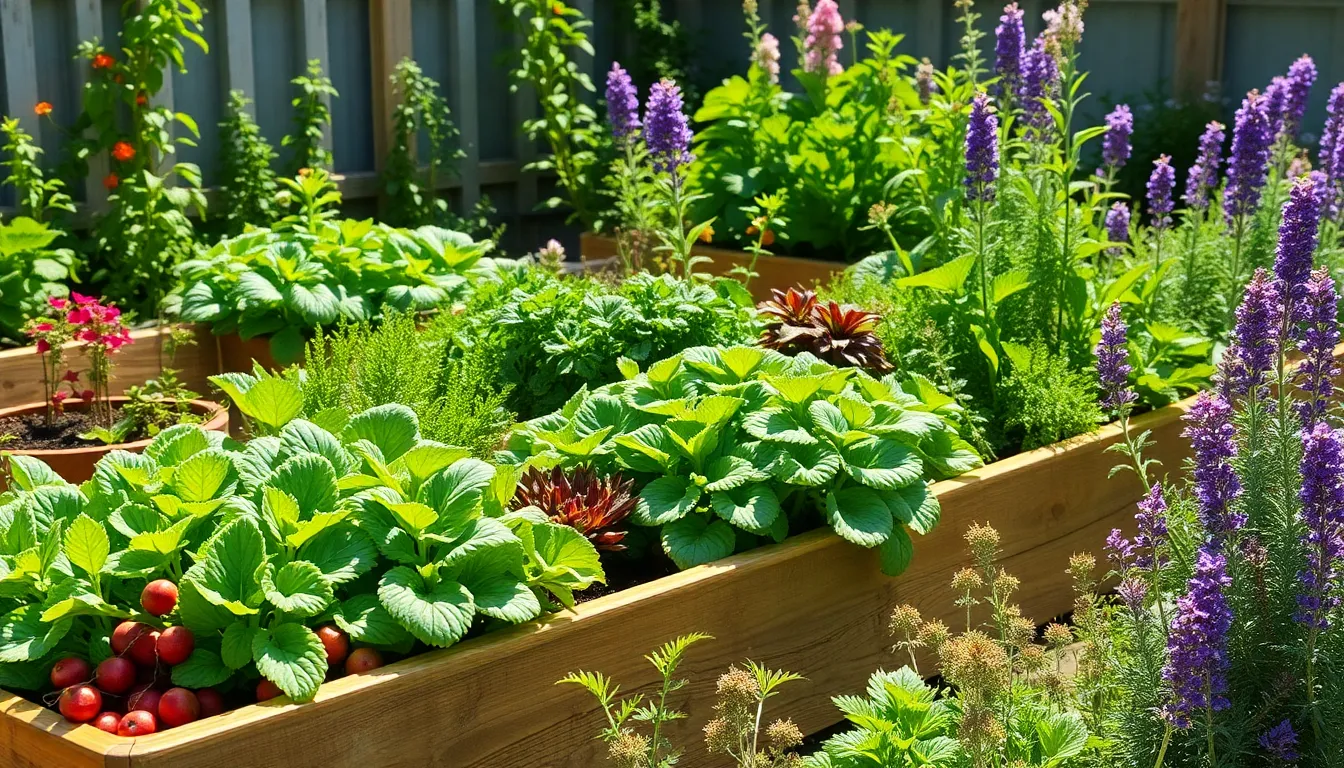
When maximizing our small garden investment, choosing plants that deliver the most produce with minimal effort makes every dollar count. These strategic selections ensure we’ll enjoy abundant harvests without complex maintenance routines.
Choose Fast-Growing Vegetables Like Radishes and Lettuce
Radishes stand out as one of our fastest small garden options, maturing in just 20 days from seed to harvest. We can plant successive crops every two weeks throughout the growing season to maintain a continuous supply of these crisp, peppery vegetables.
Lettuce varieties offer exceptional value through their “cut and come again” growing technique. Loose-leaf types like oak leaf and buttercrunch allow us to harvest outer leaves while the center continues producing new growth. Spinach works similarly, providing multiple harvests from a single planting over several months.
Both crops thrive in cooler weather, making them perfect for extending our growing season into spring and fall when other vegetables struggle. We can maximize our small space by interplanting these quick crops between slower-growing vegetables like tomatoes or peppers.
Plant Herbs That Provide Continuous Harvests
Herbs like basil, cilantro, and dill transform our small garden budget by replacing expensive store-bought seasonings with fresh alternatives. Basil produces prolifically when we pinch flowers regularly, encouraging bushy growth and extended harvests throughout summer.
Cilantro offers dual-purpose value since we can harvest both leaves and seeds (coriander). Successive plantings every three weeks ensure we’ll have fresh cilantro available as earlier plantings bolt in hot weather.
Dill self-seeds readily, creating volunteer plants for future seasons without additional seed purchases. We can harvest both the feathery leaves for fresh use and the seed heads for pickling and cooking applications.
These herbs grow quickly and can be harvested continuously without killing the plant, providing exceptional return on our initial seed investment.
Select Perennial Plants That Return Each Year
Perennial selections eliminate annual replanting costs while building our garden’s long-term value. Russian sage, lavender, and catmint thrive in full sun conditions with minimal water requirements once established.
These drought-tolerant perennials reduce our ongoing maintenance expenses while providing years of continuous blooms. Lavender doubles as a fragrant herb for cooking and crafts, maximizing its garden utility beyond ornamental value.
Topiary plants like yew, box, and privet offer structural elements that improve our garden’s aesthetic appeal year after year. We can shape these plants ourselves using basic pruning shears, creating custom designs without professional landscaping costs.
Perennials typically cost more initially than annuals, but their multi-year lifespan makes them budget-friendly investments. Many perennials can be divided after several years, creating additional plants to expand our garden or share with fellow gardeners.
Build Garden Infrastructure Using Recycled Materials
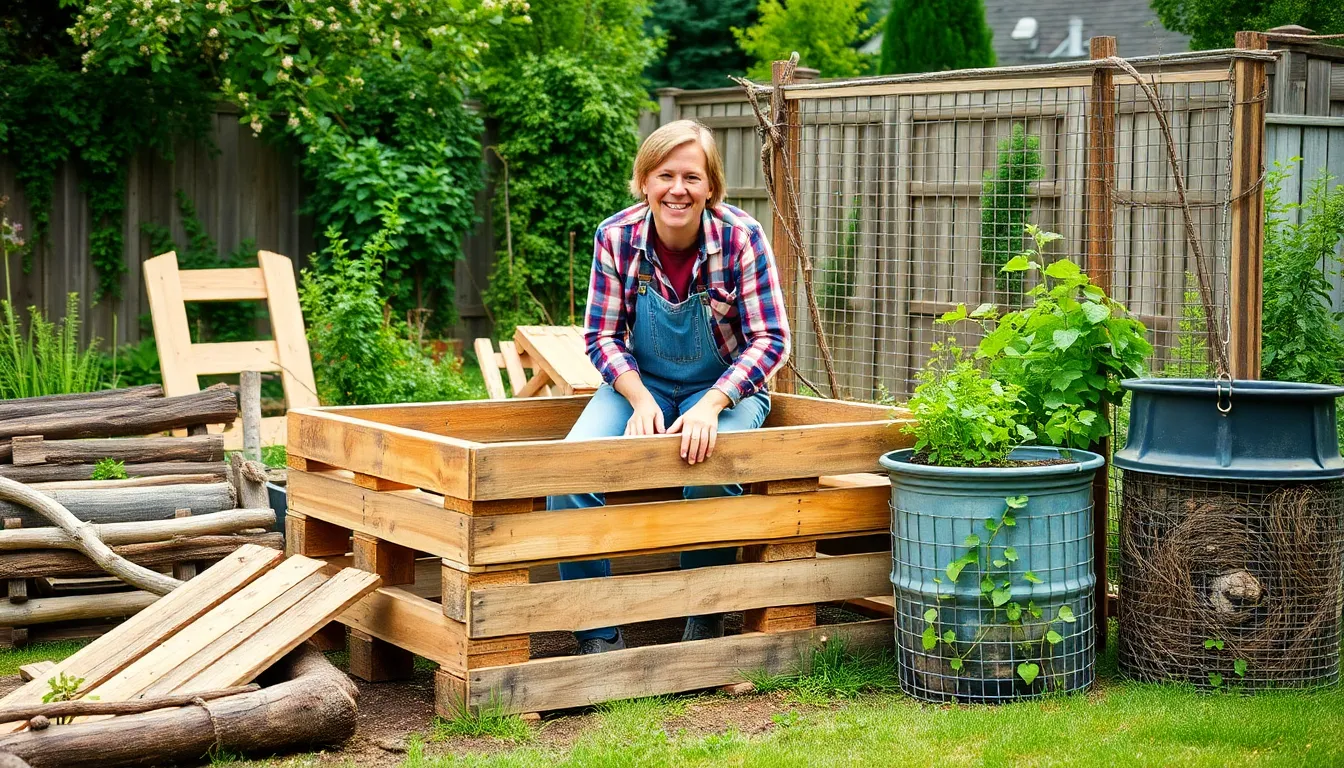
We can transform discarded materials into functional garden infrastructure while keeping costs minimal. These sustainable approaches reduce waste and provide the same benefits as expensive store-bought alternatives.
Construct Raised Beds From Free Wooden Pallets
Wooden pallets offer an excellent foundation for raised garden beds at zero cost. We can source these pallets from local businesses, construction sites, or shipping companies that often discard them regularly. Before using any pallet, we need to ensure it’s marked “HT” (heat treated) rather than chemically treated to avoid soil contamination.
Building our pallet raised beds requires minimal tools and construction skills. We simply position the pallets to form rectangular shapes, secure the corners with wood screws, and add industry fabric to the bottom. This method creates instant drainage systems that prevent waterlogged soil conditions.
These recycled raised beds provide better soil control than ground-level planting. We can fill them with quality potting mix and compost, ensuring our plants receive optimal growing conditions while avoiding poor native soil issues.
Create Trellises Using Branches and Twine
Fallen branches from our yards or local parks become sturdy plant supports with simple weaving techniques. We gather straight branches of similar thickness and create grid patterns using natural twine or gardening wire. This approach costs virtually nothing while providing essential climbing support for vegetables like beans, peas, and cucumbers.
Branch trellises blend seamlessly with natural garden aesthetics. We can arrange them in various configurations, from simple A-frame structures to elaborate archways, depending on our available materials and space requirements.
These natural supports last multiple growing seasons with proper construction. We secure the base branches firmly in the ground and weave horizontal supports every 6-8 inches, creating stable climbing surfaces that handle plant weight throughout the growing period.
Make Compost Bins From Wire Mesh or Wooden Slats
Wire mesh from hardware stores or old fencing creates effective three-sided compost bins for under $20. We shape the mesh into cylindrical or square formations, securing the edges with zip ties or wire clips. This design allows proper air circulation while containing organic materials effectively.
Wooden slats from old furniture or construction scraps build sturdy compost containers with simple assembly. We attach the slats to corner posts using screws or nails, leaving small gaps between boards for ventilation. One removable front panel provides easy access for turning and harvesting finished compost.
Our homemade compost bins process kitchen scraps, yard waste, and garden debris into valuable soil amendments. This recycling system eliminates the need for expensive bagged fertilizers while reducing household waste sent to landfills.
Take Advantage of Free Resources in Your Community
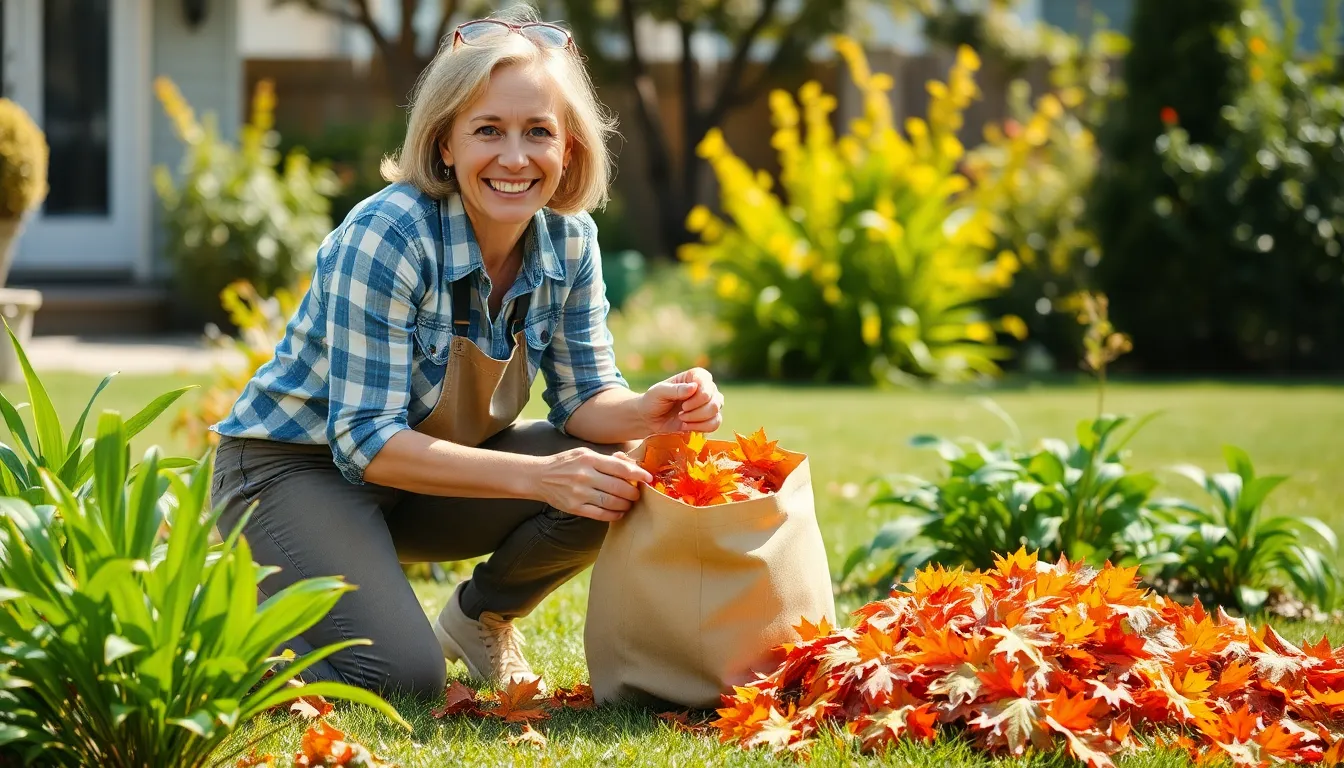
We’ve discovered that our local communities often provide valuable gardening resources at no cost. These programs and opportunities can significantly reduce our garden expenses while improving soil quality and plant health.
Collect Free Compost From Municipal Programs
Municipal compost programs offer us nutrient-rich soil amendments that would otherwise cost substantial amounts at garden centers. Many cities and towns operate composting facilities that process yard waste, food scraps, and organic materials into high-quality compost. We can typically find these programs by contacting our local waste management department or visiting city websites to locate distribution sites.
Communities often schedule exact pickup dates throughout the growing season, allowing us to stock up on this valuable resource. The compost we collect helps enrich our garden soil, improving drainage in clay soils and increasing water retention in sandy conditions. We’ll want to bring our own containers or bags since most programs require residents to load and transport the compost themselves.
Gather Fallen Leaves for Natural Mulch
Fallen leaves provide us with an abundant and completely free mulching material that performs multiple garden functions. We can collect leaves from our own yards, neighborhood streets, or ask neighbors if we can rake their leaves for them. These leaves work exceptionally well as natural mulch because they retain soil moisture, suppress weed growth, and gradually decompose to add organic matter to our garden beds.
Shredding the leaves before applying them creates a more effective mulch that won’t blow away in strong winds. We can run over them with a lawn mower or use a leaf shredder if available. The best leaves for mulching include oak, maple, and other deciduous varieties, while we should avoid using black walnut leaves since they can inhibit plant growth.
Source Free Wood Chips From Tree Service Companies
Tree service companies regularly need to dispose of wood chips from their trimming and removal jobs, making them excellent sources for free mulching material. We can contact local arborists and tree care businesses to request wood chips, and many companies will even deliver them directly to our homes at no charge. These wood chips work perfectly for garden paths, around trees and shrubs, and as general mulch throughout our garden beds.
Fresh wood chips provide long-lasting ground cover that slowly breaks down to improve soil structure over time. We should let fresh chips age for several months before applying them directly around vegetables or annual flowers, as they can temporarily tie up soil nitrogen during initial decomposition. But, we can use them immediately for pathways and around established perennial plants without any concerns.
Design Your Layout for Maximum Efficiency and Beauty
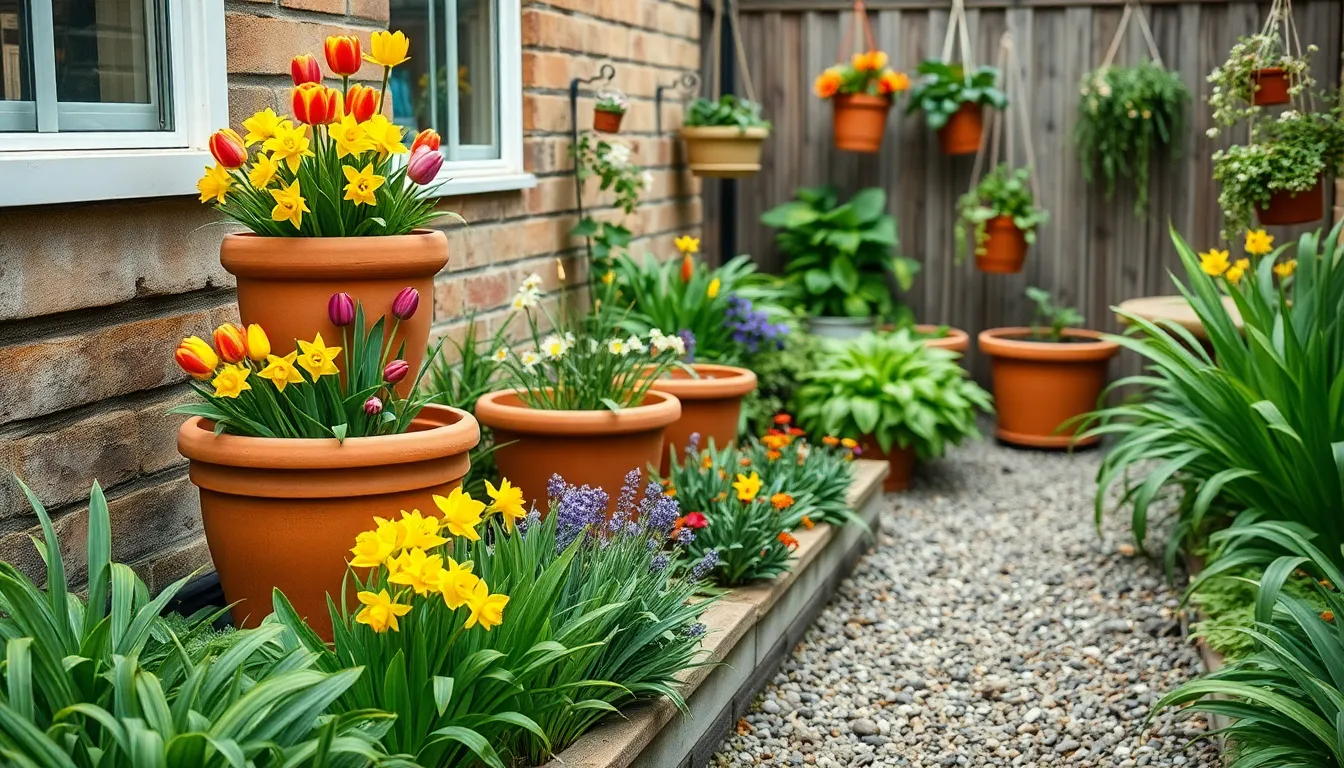
Strategic garden layout transforms cramped spaces into productive growing areas while keeping costs minimal. We’ll maximize every square inch through smart planning techniques that boost both beauty and functionality.
Plan Companion Planting to Save Space and Money
Companion planting doubles your garden’s productivity by pairing plants that naturally benefit each other. Basil planted alongside tomatoes improves tomato flavor while repelling harmful insects, creating a win-win partnership that eliminates the need for expensive pest control products.
Strategic plant partnerships reduce fertilizer costs when nitrogen-fixing plants support heavy feeders. Beans planted near corn provide natural nitrogen to the soil, while carrots paired with marigolds create natural pest deterrence that saves money on chemical treatments.
Long season plants maximize your investment by providing continuous harvests throughout multiple growing periods. Repeat flowering roses offer blooms from spring through fall, while hardy geraniums provide consistent color without annual replanting costs.
Create Defined Pathways Using Free Gravel or Mulch
Free gravel pathways establish clear garden structure while improving drainage and accessibility throughout your growing space. Contact local construction sites or landscaping companies for leftover gravel materials that would otherwise go to waste.
Mulch pathways suppress weeds naturally while retaining soil moisture and reducing maintenance time. Wood chip pathways from tree service companies create attractive walkways that decompose over time, enriching the surrounding soil with organic matter.
Strategic pathway placement maximizes planting space by creating efficient traffic flow that prevents soil compaction. Design narrow pathways that allow easy access to all plants while preserving maximum square footage for actual growing areas.
Add Visual Interest With Colorful, Budget-Friendly Plants
Terra cotta pots arranged in tiers create stunning focal points using affordable spring bulbs like tulips and daffoduls that provide early season color. Stack different sized pots to create vertical displays that maximize visual impact in minimal floor space.
Budget friendly perennials deliver long term value through plants like holly, magnolia, and peony that return year after year without replacement costs. These investment plants provide structure and seasonal interest while eliminating annual flower expenses.
Hanging planters showcase herbs and shallow rooted vegetables while freeing up valuable ground space for larger plants. Use repurposed containers or inexpensive hanging baskets to create eye catching displays that serve both decorative and functional purposes.
DIY decorative elements add personal charm through handcrafted sun catchers, painted rocks, or repurposed garden art that costs virtually nothing to create. These unique touches personalize your space while avoiding expensive store bought garden decorations.
Conclusion
Creating a stunning small garden on a budget isn’t just possible—it’s incredibly rewarding. We’ve shown you that with some creativity and resourcefulness you can transform any tiny space into a thriving green oasis without very costly.
The key lies in thinking beyond traditional gardening approaches. By embracing vertical growing techniques maximizing free community resources and choosing smart plant varieties you’ll stretch every dollar while maximizing your harvest and visual impact.
Remember that gardening is a journey of continuous learning and experimentation. Start small with one or two techniques that resonate with you then gradually expand your skills and garden as your confidence grows. Your budget-friendly garden will soon become a source of pride fresh produce and endless enjoyment for years to come.
Frequently Asked Questions
Can I really create a beautiful garden on a tight budget?
Absolutely! With creativity and smart strategies, you can build a stunning garden without breaking the bank. Focus on free resources like seed swaps, recycled materials for planters, municipal compost programs, and DIY solutions. Many gardeners successfully create thriving spaces using repurposed pallets, grocery store seeds, and plant cuttings from friends.
What are the best plants for small space gardening?
Choose high-yield, fast-growing options like radishes, lettuce, and herbs (basil, cilantro, dill). These provide multiple harvests throughout the season. Consider perennial plants like lavender, Russian sage, and catmint for long-term value without annual replanting costs. These selections maximize your investment while fitting compact spaces perfectly.
How can I maximize vertical space in my small garden?
Create vertical growing areas using repurposed pallets as wall-mounted planters, install hanging baskets on existing structures, and stack containers for tiered systems. Build simple trellises from fallen branches and twine for climbing plants. These methods save ground space while adding visual appeal and allowing for diverse plant varieties.
Where can I find free gardening materials and resources?
Check municipal compost programs for free soil amendments, collect fallen leaves for natural mulch, and contact tree service companies for wood chips. Join local seed swaps and community gardens, save seeds from grocery store produce, and ask friends for plant cuttings. Many communities offer abundant free resources for gardeners.
How do I build garden infrastructure without spending much money?
Use recycled materials like heat-treated wooden pallets for raised beds, create trellises from fallen branches and twine, and make compost bins from wire mesh or wooden slats. Repurpose containers for planters and use free gravel or mulch for pathways. These sustainable practices reduce waste while providing effective gardening solutions.
What is companion planting and how does it save money?
Companion planting involves growing compatible plants together to enhance productivity, reduce pests, and improve soil health naturally. This strategy eliminates the need for expensive fertilizers and pesticides while maximizing your harvest. Examples include planting basil with tomatoes or marigolds with vegetables to create mutually beneficial growing relationships.

